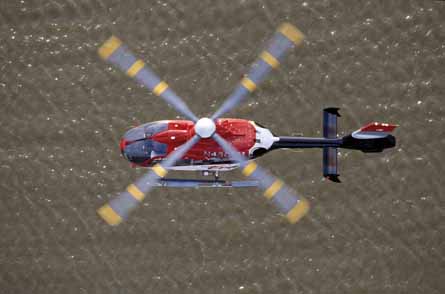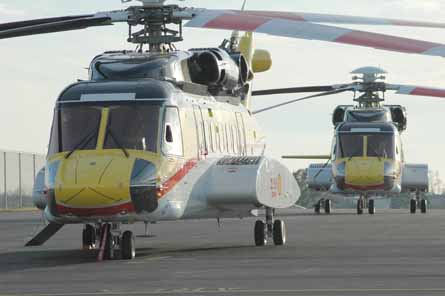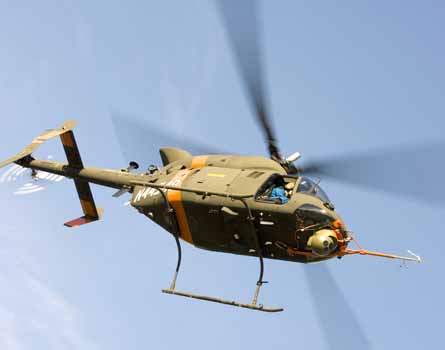Helicopter manufacturers are riding high, but demand is stretching resources while lagging research and development bodes badly for the future.
After years of stagnant sales and neglected research, helicopter manufacturers are finding it hard to keep up with production demands fuelled by the war-driven growth of the military market and a resurgence in the commercial market.
In the USA, manufacturers face challenges ramping up delivery rates and developing new helicopters for the military while tackling their biggest commercial backlogs in recent history and a European industry long dominated by the civil market is moving slowly down the learning curve on its first major international military programmes.
|
|---|
Delivery delays and development slips across the industry suggest the simultaneous take-off in demand for civil and military helicopters has caught some manufacturers unprepared and exposed a lack of engineering resources still lingering from the lows of the 1990s.
"The US industry had just weathered an aeronautics procurement drop-off of more than 50% in the 1990s, with a research and development drop-off of nearly 20% in the same period," says Rhett Flater, executive director of the American Helicopter Society (AHS). "Now we suddenly find the situation is reversed - there's a gigantic need in the USA and abroad for helicopter products."
Problems have been most apparent at Bell Helicopter and Sikorsky Aircraft, where development and production of new and upgraded rotorcraft for the US military has vied for resources with a rapidly growing commercial business. But Eurocopter has also struggled with a two-year delay in deliveries of the NH90 tactical helicopter.
Bell's problems have been most public, with chief executive Mike Redenbaugh losing his job in January after the company missed deliveries of AH-1Zs and UH-1Ys to the US Marine Corps because of production problems, forcing parent Textron to take a $50 million write-off. Sikorsky was hit by a 10-week strike last year, and missed its year-end delivery targets.
Both companies are in the midst of substantial growth. Bell's revenues are forecast to increase from under $3 billion in 2005 to as much as $4.3 billion in 2009, while Sikorsky's growth curve is even steeper - with revenues to rise from $2.8 billion in 2005 to around $3.8 billion in 2007 as the company doubles production.
Bell booms
Bell's commercial deliveries rose 30% last year, to 160 helicopters, and are to grow another 13% this year to 180 aircraft - 130 light turbines and 50 intermediate and medium twins. That will not include the new Model 417 light single and Model 429 light twin, first deliveries of which have slipped to 2008-9. Bell had a year-end backlog of more than 125 417s and 190 429s.
This growth comes as Bell struggles with its military programmes, with delays to production of the upgraded H-1s and development of the US Army's ARH-70A armed reconnaissance helicopter (ARH). The crush of production and development work has resulted in higher overheads, more expensive components and significant rework costs.
The latest $50 million write-off on the H-1 programme came after the USMC flagged up issues with the first production helicopters during a pre-purchase inspection late last year. The resulting rework required a "marching army" of engineers and product support specialists to push the modifications through the design process, Textron chairman Lewis Campbell told analysts earlier this year.
Bell finally delivered the first production AH-1Z and UH-1Y in January, and plans to ramp up to 16 a year by 2010. Over the same period, it has to increase deliveries of the Bell Boeing V-22 tiltrotor to 29 a year and get the ARH-70 into production. The ARH is now almost a year behind schedule, after significant redesign, and Campbell warns that Bell will lose $2-4 million on each of the first 48 helicopters unless it can renegotiate the price.
"We've ramped up overhead costs all over Bell," says Campbell. "It's all the things people have been doing to get production out at the in-house component shops," he says, referring to "turbulence" within the Fort Worth, Texas facilities that produce dynamic components for commercial helicopters assembled in Montreal, Canada as well as military rotorcraft assembled in Amarillo, Texas.
Bell has a recovery plan to "get that overhead out of the business", says Campbell, and it includes outsourcing components. "We have more volume than our factories will support," he says, and Bell has to "move more quickly than normal to off-ramp" some of the component supply rather than invest in more in-house capability. "I don't want to put capital in when we're going to lean the place out," he says.
The company says it has been making its production lines leaner for several years, and has bought new tooling to boost internal capacity for produce components. Bell says new president and chief executive Richard Millman has not yet decided to outsource component supply, despite Campbell's comments.
More jobs
Bell's Canadian plant added around 200 employees last year and is expanding its engineering, manufacturing and flight-test facilities in anticipation of commercial helicopter deliveries ramping up to 225-275 in 2010, including ARH-70s. But Bell is taking things slower with the new 417 and 429, saying: "We're going to do this right so that, when we finally deliver, it doesn't come back for fixes. We are more inclined to work it at the right pace rather than some artificial date."
A similar tale of demand outstripping supply can be heard at Sikorsky, which was also hit by a strike. "You can multiply the effects of the strike and the ramp-up - you lose a month while doubling production and there's quite an impact," says Jeff Pino, who took over as president a month before the strike hit. "But we've tracked throughput since April, and achieved higher output every month."
Briefing analysts late last year, George David, chairman of parent company United Technologies, said Sikorsky was tackling three problems simultaneously: doubling production of civil and military helicopters from 2005 to 2007 reconfiguring how it builds helicopters, including outsourcing components and recovering from the strike. "There are tough issues at Sikorsky, which is struggling with the volume challenge," he says. "They have made progress at the component level, but are still behind in final assembly and will not recover until the second half of 2007."
Sikorsky's biggest challenge is meeting the US military's demand for Black Hawks and Naval Hawks, with production of H-60 helicopters planned to more than double from 51 in 2005 to 110 in 2007. Production of S-76 and S-92 commercial helicopters is increasing from 49 to 70 over the same period, but the relative smoothness of that ramp-up holds the key, the company believes.
"We decided when we went through the ramp-up on commercial over the past three years that the commercial business model could withstand a production ramp better than the historical military model," says Pino. As a result, Sikorsky has completely changed the way it produces helicopters, abandoning its former vertical integration in favour of distributed engineering and outsourcing.
Cabins for commercial helicopters are fabricated by international suppliers then sent to a third party for assembly - Aero Vodochody in the Czech Republic for the S-76 and Sikorsky's Keystone Helicopters subsidiary in Philadelphia for the S-92. Mated cabins with basic plumbing and wiring installed are then shipped to Sikorsky's Stratford, Connecticut plant for final assembly. Completed S-76s and S-92s are sent back to Keystone for customisation and delivery. Keystone will also assemble S-76s as production increases to almost 50 aircraft this year.
Commercial lesson
"Stratford produces the same product every time, and sends it to Keystone for customisation. This model has withstood the production ramp-up," says Pino. "On the military side we were clearly getting behind, so we decided that what we did with commercial we would do with military." The result is a simplification of the Stratford operation, but complex web of outsourcing that has presented its own problems.
Naval Hawks - US Navy MH-60R Romeos and MH-60S Sierras - are built at a Sikorsky plant in Troy, Alabama and at Vought in Dallas, Texas, with cockpits from Kaman in Jacksonville, Florida and tailcones from Turkey. Final assembly is at Stratford.
|
|---|
Sikorsky says the S-92's showing in the off-shore-oil market is attracting attention from other sectors |
US Army UH-60M ("Mike") Black Hawks are built in Stratford and at Vought. "To keep a bit of control over the supply chain, one source is always Sikorsky-owned," says Pino. Production of the UH-60L model, meanwhile, has been outsourced to L-3 Crestview in West Palm Beach, Florida while the International Black Hawk - a UH-60L/M hybrid for the export market - will be assembled in Poland at PZL-Mielec, which Sikorsky bought this year.
All customisation has been removed from military production. "Stratford builds a standard-configuration US Army Mike and ships it to a new facility at Schweizer for customisation," says Pino, adding that the first aircraft will arrive its Elmira, New York-based subsidiary's new Hawk Works in April. "Crestview builds the standard green UH-60L. US Army production ends this May, then there is another year of production of international customers," he says.
After this reconfiguration, the Stratford plant has just three lean-flow H-60 lines producing four Mikes, two Romeos and two Sierras a month, with a fourth line to be added for the medical-evacuation version of the UH-60M. "We used to have nine variants," says Pino, describing the change as "lean to the ultimate".
The change brought challenges, and Sikorsky ended last year 13 helicopters - two months' production - behind schedule. At its worst, just after the strike, the company was 900,000 shop hours overdue, but reduced this to 400,000h by year-end with the backlog expected to be eliminated by the second quarter, allowing final assembly to get back on schedule by the second half of the year.
Supply issues
"There have been supply-chain issues because of how fast we are moving, but we are really pleased with this new model. We changed in nine months, and nothing makes you focus like the fear of failure," Pino says. "By the fourth quarter of 2006 we were actively producing everything we are looking for in 2007. Our goal last year was to get stable, and the fourth quarter showed it is going to work."
With six new-aircraft or major-modification development programmes under way, including the CH-53K heavylift helicopter for the US Marine Corps, Sikorsky's engineering resources have also been stretched. "We looked at our engineering resources a year ago and decided we needed 1,000 engineers. But not everyone wants to move to Stratford," says Pino.
|
|---|
Redesign of Bell's ARH-70A, and civil Model 417 on which it is based, has led to delays |
As a result, Sikorsky set up three contract design centres in Indiana, Kentucky and Montana, which have around 250 engineers, and three company-owned centres in Fort Worth, Troy and Huntsville, Alabama with around 600 employees. Pino says the company is also looking further afield, to Puerto Rico as well as India and China.
Eurocopter is also responding to pressure on resources as a rapidly expanding military business adds to its continued commercial growth. "With the NH90 and Tiger, we have entered a new stage in the complexity of the set-up," says chief executive Lutz Bertling. "We have 13 customers for the NH90 and 20 configurations, each of which needs military certification in the country in which it is flying."
This has led to delays, with the first NH90s being handed over to the German army in December, two years late. "There have been lots of learning curves," says Bertling. "We have had to react resources-wise, not only in engineering, but also in international programme management." Without Eurocopter's experience of co-operation with the likes of China and India it would have been more difficult, he says.
Eurocopter is also looking internationally to meet production demands. "There is pressure on our overall supply chain, and we are constantly reviewing it," says Bertling. "We have a huge network of subsidiaries with industrial operations, so we are using that advantage. Part of our business model is this incredible industrial footprint. We are building in Spain, the USA, in the Nordic region with Patria, in Japan with Kawasaki and in India with HAL."
American Eurocopter is in full ramp-up mode, booking 153 orders last year and beginning deliveries of US-made AS350B2/B3s from its new Columbus, Mississippi plant, which will assemble the US Army's UH-72A version of the EC145. Rising demand has posed two inter-related challenges - getting raw materials and components and cutting lead time to 18 months or less, the most buyers will wait, says Larry Roberts, vice-president, commercial affairs.
Production challenges
The company is pursuing "all avenues" to increase production, including looking outside its traditional supplier base. "We're opening the competition to all parts of the world for components, airframe parts and avionics," says Roberts. Key challenges, he says, include co-ordinating the raw materials pipeline and negotiating contracts.
AHS's Flater, meanwhile, sees the crush of new work as worrisome in two ways, arguing companies are scrambling to produce minimal-risk designs while money being funnelled into the US military effort means little is left to carry out research even if industry had time to do it. Rather than transformational, the improvements being made are incremental, he says.
"We need to reduce helicopter empty weight by 30%, cut vibration by a factor of 10, reduce noise and improve safety dramatically," says Flater. "We're not making these investments because we're making the investment in sustaining operations in Iraq and Afghanistan." The 20t-payload Joint Heavy Lift rotorcraft is one of the programmes caught in the US research and development funding vacuum, he says.
Flater says a "sustained investment" of about $2 billion a year for the next five to seven years is needed, all of it devoted to basic rotorcraft research. But NASA, the primary source for new technologies for the US commercial sector, has had its aeronautics budget cut to around $550 million a year, of which a fraction is to be spent on fundamental rotary-wing research only.
Rather than applying additional money to basic research, Mike Romanowski, vice-president, civil aviation for the US Aerospace Industries Association, says it should be spent on "transitional" technologies that result in the construction of "demonstrators and validators". One example he offers is the development of new instrument flight rules that take advantage of the unique capabilities of rotorcraft.
A victim of R&D cuts is the supply of engineers with advanced degrees from universities carrying out government-funded research. Last year, the University of Maryland lost to Penn State University and Georgia Institute of Technology as the army cut back from three to two rotorcraft research centres of excellence. Maryland had been an incubator for advanced-degree graduates who later went to Sikorsky, says Flater, and the cuts could be laying the foundations for future problems.
Source: Flight International


























